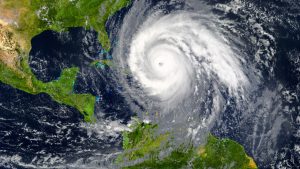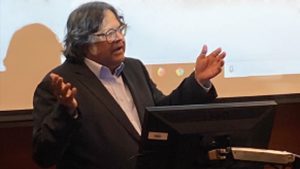
Shahid Hamid, professor in the Department of Finance in the College of Business Administration, director of Florida International University’s International Hurricane Research Center (IHRC)’s Laboratory for Financial, Insurance, and Economic Research, and lead investigator on the project.

Researchers who worked on the model, International Hurricane Research Center (IHRC) affiliates and board members, and other interested parties attended an unveiling of the model at Modesto A. Maidique Campus on May 9, 2006.
Hurricane season has arrived again, and South Floridians, among others, are understandably jittery—not only about the possibility of a strike but also about the reality of insurance rate increases. Since insurance companies use proprietary models to determine hurricane losses—and from that, insurance rates—how can regulators determine the appropriateness of requested hikes?
A computer model, developed over hundreds of thousands of person-hours and drawing upon the expertise of fifteen meteorologists, wind engineers, computer scientists, statisticians, financial analysts, and actuary scientists plus more than a dozen graduate students scattered throughout Florida, will help the insurance regulators do just that. Shahid Hamid, professor in the Department of Finance in the College of Business Administration and director of Florida International University’s International Hurricane Research Center (IHRC)’s Laboratory for Financial, Insurance, and Economic Research, was the lead investigator on the project. He was on hand when the “Hurricane Insured Loss Projection Model” was unveiled in the MARC Pavilion at Modesto A. Maidique Campus on May 9, 2006.
“Insurance companies use commercial models but keep the process secret,” he said. “The State commissioned a public model so regulators would not have to take the information on faith. Our model, which is independent of both the insurance industry and the State regulatory agencies, makes the information—including the underlying assumptions on which it is based—clear to the person reading the reports we produce.”
The principal objective of the computer model—which had to meet two hundred standards in computer science, actuarial science, meteorology, engineering, and statistics—is to estimate annual expected insured losses and probable maximum loss as a result of hurricanes, which companies use to determine their windstorm rates. It also can provide immediate estimates of losses from specific hurricane events like Charley, Katrina, and Wilma.
Future funding will expand applications.
Additional funding will make it possible to gather information on the impact of mitigation efforts: for example, the degree to which hurricane shutters mitigate losses. The information is important because hurricane damage must be lowered to sustain Florida’s economy. Increased funding also will enable researchers to expand the model to include commercial structures such as condominiums and apartment buildings, which constitute a large portion of Florida’s structures; currently, only residential structures are included.
The State began using the model in December, 2005. The model was calibrated mostly to pre-2004 storms and, in particular, to Hurricane Andrew. The project team currently is updating the model with data from more recent storms.
“Ten percent of the storms in the last 100 years have occurred in the last two years,” Hamid said. “We now are recalibrating the model with new data.”
Information sharing is underway.
Team members—about 40 percent of them from the university—already have published a number of papers based on their findings and many more reports are expected. Though much of the information amassed by the researchers—such as reports and flowcharts—will be shared, the source code will remain proprietary.




